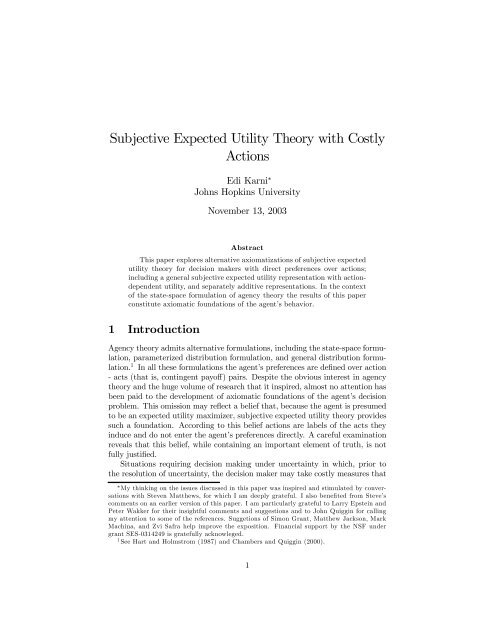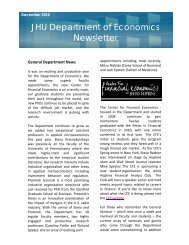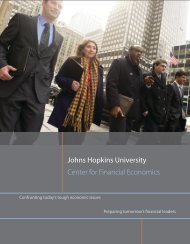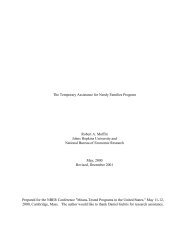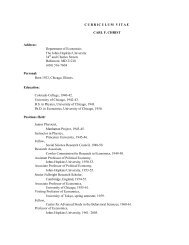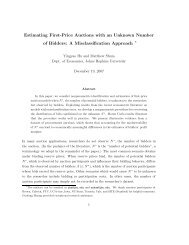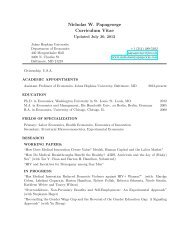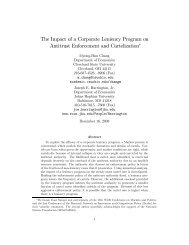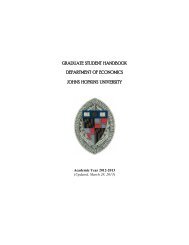Subjective Expected Utility Theory with Costly Actions - Economics ...
Subjective Expected Utility Theory with Costly Actions - Economics ...
Subjective Expected Utility Theory with Costly Actions - Economics ...
You also want an ePaper? Increase the reach of your titles
YUMPU automatically turns print PDFs into web optimized ePapers that Google loves.
<strong>Subjective</strong> <strong>Expected</strong> <strong>Utility</strong> <strong>Theory</strong> <strong>with</strong> <strong>Costly</strong><br />
<strong>Actions</strong><br />
Edi Karni ¤<br />
Johns Hopkins University<br />
November 13, 2003<br />
Abstract<br />
This paper explores alternative axiomatizations of subjective expected<br />
utility theory for decision makers <strong>with</strong> direct preferences over actions;<br />
including a general subjective expected utility representation <strong>with</strong> actiondependent<br />
utility, and separately additive representations. In the context<br />
of the state-space formulation of agency theory the results of this paper<br />
constitute axiomatic foundations of the agent’s behavior.<br />
1 Introduction<br />
Agency theory admits alternative formulations, including the state-space formulation,<br />
parameterized distribution formulation, and general distribution formulation.<br />
1 In all these formulations the agent’s preferences are de…ned over action<br />
- acts (that is, contingent payo¤) pairs. Despite the obvious interest in agency<br />
theory and the huge volume of research that it inspired, almost no attention has<br />
been paid to the development of axiomatic foundations of the agent’s decision<br />
problem. This omission may re‡ect a belief that, because the agent is presumed<br />
to be an expected utility maximizer, subjective expected utility theory provides<br />
such a foundation. According to this belief actions are labels of the acts they<br />
induce and do not enter the agent’s preferences directly. A careful examination<br />
reveals that this belief, while containing an important element of truth, is not<br />
fully justi…ed.<br />
Situations requiring decision making under uncertainty in which, prior to<br />
the resolution of uncertainty, the decision maker may take costly measures that<br />
¤ My thinking on the issues discussed in this paper was inspired and stimulated by conversations<br />
<strong>with</strong> Steven Matthews, for which I am deeply grateful. I also bene…ted from Steve’s<br />
comments on an earlier version of this paper. I am particularly grateful to Larry Epstein and<br />
Peter Wakker for their insightful comments and suggestions and to John Quiggin for calling<br />
my attention to some of the references. Suggetions of Simon Grant, Matthew Jackson, Mark<br />
Machina, and Zvi Safra help improve the exposition. Financial support by the NSF under<br />
grant SES-0314249 is gratefully acknowleged.<br />
1 See Hart and Holmstrom (1987) and Chambers and Quiggin (2000).<br />
1
a¤ect the consequences associated <strong>with</strong> some states do not arise exclusively in<br />
the context of principal-agent relationships. Indeed, such situations are common<br />
in economic analysis and often arise even when the decision maker acts in<br />
isolation. For instance, Robinson Crusoe may have to choose between building<br />
his hut on a ‡ood plane or on high grounds and thereby, at a cost, a¤ect the<br />
consequences of ‡ooding. Robinson Crusoe’s choice is not adequately captured<br />
by traditional subjective expected utility theory because in that theory (e.g.,<br />
Savage (1954)) the choice set includes all acts (that is, all assignments of consequences<br />
to states) and, more importantly, acts do not enter the preferences<br />
directly. This framework is inadequate to describe the choice facing Crusoe.<br />
Building his hut on high grounds involves a larger expense of time and e¤ort.<br />
Moreover, because the time and e¤ort to be spent must be determined in advance,<br />
they cannot vary <strong>with</strong> the state of nature (e.g., they cannot depend on<br />
the amount of precipitation). Put di¤erently, to …t into Savage’s framework,<br />
the time and e¤ort spent building the hut must be incorporated into the description<br />
of the consequences and the set of acts must include all assignments<br />
of consequences to states. The problem is that the decision of where to locate<br />
the hut must be made prior to the realization of the state yet acts, such as f<br />
described below, must be contemplated:<br />
States Flood No Flood<br />
f<br />
Hutlostina‡ood.<br />
Little time and e¤ort spent<br />
building hut on ‡ood plan<br />
Hut stands.<br />
Signi…cant amount of time and e¤ort spent<br />
building hut on high ground<br />
Put in more general terms, let X be the set of outcomes and denote by A the<br />
set of actions (e.g., the hut damaged by a ‡ood is a consequence and time and<br />
e¤ort spent is an action). If consequences are de…ned as action-outcome pairs<br />
then Savage’s set of acts is given by (A £ X) S ; where S denotes the set of states<br />
of nature. But, as the above example suggests, this set contains acts that are<br />
incredible. To suppose that the decision maker is able to express meaningful<br />
preferences as regards such acts creates a conceptual di¢culty <strong>with</strong> the theory. 2<br />
This di¢culty is averted if, for instance, the only cost of actions is the<br />
…nancial cost and the consequences represent …nancial rewards then actions are<br />
indeed labels of the corresponding acts. To see this, let c (a) denote the …nancial<br />
cost of implementing the action a and denote by x (s; a) the state-contingent<br />
action-dependent monetary payo¤, then the state-contingent payo¤ function<br />
xa (¢) =x (¢;a)¡c(a) is a Savage-type act and a is its label. In this example the<br />
fact that the cost of action and the reward are additive is essential. However,<br />
if the action involves spending time (e.g., while seeking employment) and the<br />
state-contingent payo¤ is monetary (e.g., wages or unemployment insurance<br />
bene…ts depending on the eventual state of employment) then, not being perfect<br />
substitutes, actions must be separated from acts.<br />
2 I am indebted to Steve Matthews for suggesting this discussion of Savage’s theory.<br />
2
It seems, therefore, that an examination of the axiomatic foundations of subjective<br />
expected utility theory for decision makers <strong>with</strong> direct preferences over<br />
actions is warranted. As in other …elds, this study is intended to uncover and<br />
allow clearer understanding of the behavioral premises underlying the theory,<br />
thereby opening the way to a critical examination of its basic tenets.<br />
In this paper I invoke the state-space formulation and pursue an approach in<br />
which decision makers are supposed to have preference relations on M(A)£F jAj ;<br />
where M (A) is the set of probability measure on A; and F is the subset of X S<br />
containing all the simple acts: The resulting model …ts naturally situations in<br />
which the eventual outcome is determined by the state of nature and stateindependent<br />
actions taken by the decision maker, such as the decisions of the<br />
agent in agency theory.<br />
2 Preference Structures and Representations<br />
2.1 Preliminaries<br />
Let S be an in…nite set whose elements are states of nature and whose subsets<br />
are events. Consequences, or outcomes, are real numbers representing monetary<br />
payo¤s. Let the set of outcomes, X; be a compact interval in the real line.<br />
Following Savage (1954), an act is a function from the set of states to the set<br />
of outcomes. Let F denote the set of simple acts, namely, acts under which the<br />
image of S is …nite. Assume that F is endowed <strong>with</strong> the product topology, then<br />
it is a compact set. Denote by f a generic element of F and by x the constant<br />
act f (s) =x for all s 2 S:<br />
Let A = fa1; :::; ang; 2 · n
The next axiom requires that the evaluation of coordinates is independent<br />
in the sense that preferences among alternatives of the form (e i ; (f;f¡i)); where<br />
(h; f¡i) :=(f1;:::;fi¡1;h;fi+1; :::; fn) ; depends solely on the i¡th coordinate of<br />
f. Formally,<br />
(A.3) (Certainty Principle) For all f; g; h; l 2 F n ; (e i ; (f;f¡i)) < (e i ; (g; g¡i))<br />
if and only if (e i ; (f;h¡i)) < (e i ; (g; l¡i)):<br />
In view of the certainty principle, to simplify the notations, I shall henceforth<br />
write (ai;f) < (aj;f 0 ) instead of (e i ; (f;f¡i)) < (e i ; (f 0 ; g¡j)):<br />
To introduce the next axiom de…ne a partial mixture operation on D: Let<br />
(®; f) and (¯;f) in D then (¸® +(1¡ ¸)¯;f) ;¸2 [0; 1] is an element of D such<br />
that (¸® +(1¡ ¸)¯)i = ¸®i +(1¡ ¸)¯ i: This may be interpreted as a two-stage<br />
lottery in which in the …rst stage the alternatives (®; f) and (¯;f) are obtained<br />
<strong>with</strong> probabilities ¸ and 1 ¡ ¸; respectively. In the second stage the coordinate<br />
of f is selected by the lottery, ® or ¯, that corresponds to the outcome of the …rst<br />
stage. With this interpretation in mind assume that the decision maker prefers<br />
(®; f) over (® 0 ; g) and (¯;f) over (¯ 0 ; g): Moreover, assume that if a decision<br />
maker faces a choice between the alternatives d =(¸® +(1¡ ¸)¯;f) and d 0 =<br />
¡ ¸® 0 +(1¡ ¸)¯ 0 ; g ¢ he reasons as follows: If the event whose probability is ¸ is<br />
realized then he participates in the lottery (®; f) if he has chosen d andinthe<br />
lottery (® 0 ; g) if he has chosen d 0 : Conditional on the realization of this event, he<br />
is better o¤ <strong>with</strong> d: Bythesamelogichewouldalsopreferd over d 0 conditional<br />
on the realization of the event whose probability is 1 ¡ ¸: Consequently, he<br />
prefers d over d 0 unconditionally. Formally,<br />
(A.4) (Constrained Independence) For all (®; f), (¯;f),(® 0 ; g), (¯ 0 ; g) in<br />
D and ¸ 2 [0; 1) if (®; f) » (® 0 ; g) then (¯;f) < (¯ 0 ; g) if and only if<br />
(¸® +(1¡ ¸)¯;f) < ¡ ¸® 0 +(1¡ ¸)¯ 0 ; g ¢ :<br />
Constrained independence is weaker than the independence axiom of expected<br />
utility theory (see discussion in Karni and Safra [2000]).<br />
A real-valued function V on D is said to represent < if, for all (®; f) and<br />
(¯;g) in D; (®; f) < (¯;g) if and only if V (®; f) ¸ V (¯;g) :<br />
Theorem (Karni and Safra [2000]) Let < be a binary relation on D. Then<br />
the following conditions are equivalent:<br />
(a) < is a preference relation satisfying (A.1)-(A.4).<br />
(b) There exist continuous non-constant functions V : D ! R and U (¢; ai) :<br />
F ! R; ai2 A, such that V represents < and, for all (®; f) 2 D;<br />
nX<br />
V (®; f) = ®iU(fi; ai):<br />
Moreover, if there are functions W : D ! R and W (¢; ai) :F ! R;ai 2 A;<br />
such that W represents < and W (®; f) = Pn i=1 ®iW (fi; ai); then W (¢; ai) =<br />
BU (¢; ai)+C; B > 0.<br />
4<br />
i=1
2.2 The main result<br />
For each a 2 A de…ne a conditional preference relation,
Theorem 1 Let < be a binary relation on D; then the following conditions are<br />
equivalent:<br />
(i) < is a preference relation satisfying (A.1) - (A.7).<br />
(ii) There exist a nonatomic probability measure, ¼; on S, and continuous<br />
real-valued functions, u on X and ª on A £ R; such that V represents <<br />
and, for all (®; f) 2 D;<br />
V (®; f) =<br />
nX<br />
i=1<br />
®i<br />
Z<br />
S<br />
ª(ai;u(f (s)) d¼ (s) ; (1)<br />
where ª(a; ¢) is a monotonic increasing transformation. Moreover, ¼ is<br />
unique <strong>with</strong> ¼(E) > 0 if and only if E is null, and u is unique up to<br />
positive linear transformation.<br />
Remark: In reality decision makers choose among action-act pairs. Theorem<br />
1 implies that the restriction of the preference relation < to A £ F has the<br />
following representation: For all (a; f) and (a 0 ;f 0 ) in A £ F;<br />
(a; f) < (a 0 ;f 0 ) ,<br />
Z<br />
S<br />
Z<br />
ª(a; u (f (s)) d¼ (s) ¸<br />
Hence the representation in (2) is applicable.<br />
ª(a<br />
S<br />
0 ;u(f 0 (s))) d¼ (s) : (2)<br />
Proof.<br />
(i) ! (ii) :<br />
The proof that (ii) ! (i) is straightforward. I shall prove that<br />
Axiom (A.5) and Savage’s (1954) theorem imply that, for every given a 2 A;<br />
there exist a nonatomic probability measure ¼ (¢; a) on S and a real-valued<br />
function, u; on X such that,<br />
Z<br />
U(f; a) = u (f (s) ;a) d¼ (s; a) : (3)<br />
S<br />
where ¼ (¢; a) is unique and u (¢;a) is unique up to positive linear transformation.<br />
Moreover, U(f; a) represents
where, for each E µ S; ¼ (E;a) = R<br />
E<br />
u (x0 ;a) > 0 if and only if u (x; a0 ) ¡ u (x0 ;a0 ) > 0: Hence<br />
¼ (s; a) ds: But, by (A.6), u (x; a) ¡<br />
¼ (E;a) ¡ ¼ (G; a) ¸ 0 , ¼ (E;a 0 ) ¡ ¼ (G; a 0 ) ¸ 0: (7)<br />
But equation (7) implies that, for every E µ S and all a; a 0 2 A; ¼ (E;a) =<br />
¼ (E;a 0 ) = ¼ (E) : To prove the last assertion suppose, by way of negation,<br />
that for some E ½ S and a; a 0 2 A; ¼ (E;a) >¼(E;a 0 ) : Because the measures<br />
¼ (¢;a) ;a 2 A are nonatomic, by Liapunov’s theorem 3 there exist K ½ S such<br />
that ¼ (E;a) >¼(K; a) =¼ (K; a 0 ) >¼(E;a 0 ) : (To see this observe that the<br />
point (¼ (E;a) ;¼(E;a 0 )) is below the diagonal of the unit square. But, by<br />
Liapunov’s theorem, the set f(¼ (T;a) ;¼(T;a 0 )) 2 [0; 1] 2 j T 2 2 S g is closed,<br />
convex and contains the diagonal. Let r satisfy ¼ (E;a) >r>¼(E;a 0 ) and K<br />
be an event whose image under (¼ (¢;a) ;¼(¢;a 0 )) is on the diagonal and satis…es<br />
¼ (K; a) =¼ (K; a 0 )=r:) Then Substituting K for G in equation (7) leads to a<br />
contradiction. Hence ¼ (¢; a) =¼ (¢) for all a 2 A: Moreover, it is easy to verify<br />
that ¼ (E) > 0 if and only if E is null.<br />
Equation (3) together <strong>with</strong> the Theorem of Karni and Safra (2000) imply<br />
that<br />
V (®; f) =<br />
nX<br />
i=1<br />
®i<br />
Z<br />
u(fi (s) ;ai)d¼ (s) ;<br />
S<br />
where V and u are continuous functions. But, by (A.6), u(¢;a) is ordinally equivalent<br />
to u (¢;a 0 ) for all a; a 0 2 A: Hence, for all ai 2 A; u(¢;ai) =ª(ai;u(¢;a1))<br />
where ª(ai; ¢) is monotonic increasing continuous transformation. Let u(¢) =<br />
u(¢;a1) to obtain the representation in (ii) :<br />
The uniqueness follows from Savage’s theorem.<br />
2.3 Action-a¢ne utility representation<br />
Insofar as the dependence of the utility function on the action is concerned,<br />
the result in Theorem 1 is quite general. In some applications the e¤ect of<br />
the choice of action on the decision maker’s well-being calls for a more speci…c<br />
functional form of the utility function. For example, when actions correspond to<br />
levels of e¤ort, it is commonplace to assume some form of separability between<br />
the utility of money and the utility of e¤ort. I explore next the axiomatic<br />
underpinnings of two alternative, more speci…c, representations of the decision<br />
maker’s preferences. The …rst, action-a¢ne utility representation, was used in<br />
Grossman and Hart (1983).<br />
The next axiom requires that, for any given event, E; the “intensity of preferences”<br />
between consequences on the complementary event S ¡E be independent<br />
of the action. The formal statement of this idea is an adaptation of Wakker’s<br />
(1987) cardinal consistency axiom. 4<br />
3 See Hildenbrand (1974).<br />
4 See Karni (2003, 2003a) for di¤erent adaptations of the same idea.<br />
7
(A.8) (Action-independent intensity of preferences) For all f;g;h;l 2<br />
F , a; a0 2 A, E ½ S; and w; x; y; z; 2 X, iffEw
Proof. (i) ) (ii) : Fix an event E ½ S such that both E and S ¡ E are<br />
nonnull and a 2 A; then, by Theorem 1, there exist f;g;2F andsuchthat<br />
Z<br />
[ª (a; u(f (s))) ¡ ª(a; u(g (s)))] d¼ (s) =³>0: (10)<br />
E<br />
Given a0 2 A; by Theorem 1, there exist acts h; l 2 F that satisfy<br />
Z<br />
[ª (a<br />
E<br />
0 ;u(h (s))) ¡ ª(a 0 ;u(l (s)))] d¼ (s) =">0. (11)<br />
By continuity of the functions ª(a; ¢) and u; for every ^ ³ 2 [¡³;³]; ^" 2 [¡"; "];<br />
there exist f 0 ;g 0 ;h 0 ;l 0 2F and such that<br />
and<br />
Z<br />
Z<br />
[ª (a; u(f<br />
E<br />
0 (s))) ¡ ª(a; u(g 0 (s)))] d¼ (s) = ^ ³ (12)<br />
[ª (a<br />
E<br />
0 ;u(h 0 (s))) ¡ ª(a 0 ;u(l 0 (s)))] d¼ (s) =^". (13)<br />
De…ne Á a 0 by ª(a 0 ;u(¢)) = Á a 0 ± ª(a; u(¢)) for all a 0 2 A: Then Á a 0 is<br />
a continuous function. To show that Á a 0 is positive a¢ne or constant take<br />
®; ¯; °; ± 2 R such that ¡³ · ® ¡ ¯ = ° ¡ ± · ³ and ¡" · Á a 0 (¯) ¡ Á a 0 (®) · ":<br />
Let w; x; y; z 2 R satisfy ª(a; u(x)) ¼ (S ¡ E) =®; ª(a; u(w)) ¼ (S ¡ E) =¯;<br />
u (z; a) ¼ (S ¡ E) =° and ª(a; u(y)) ¼ (S ¡ E) =±: Take ^ f;^g 2 F such that<br />
Z<br />
E<br />
h ³<br />
ª a; u( ^ ´<br />
i<br />
f (s)) ¡ ª(a; u(^g (s))) d¼ (s) =® ¡ ¯: (14)<br />
Thus ^ fEw »a ^gEx and ^ fEy »a ^gEz:<br />
Take ^ h; ^ l2F such that,<br />
Z<br />
E<br />
h ³<br />
ª a 0 ;u( ^ ´ ³<br />
h (s)) ¡ ª a 0 ;u( ^ ´i<br />
l (s)) d¼ (s) =Áa0 (®) ¡ Áa0 (¯) : (15)<br />
Since ª(a 0 ;u(¢)) = Á a 0 ± ª(a; u(¢)) this implies ^ hEw »a 0 ^ lEx: Applying (A.8)<br />
twice yields ^ hEy »a0 ^lEz: Thus<br />
Z<br />
Á a 0 (±) ¡ Á a 0 (°) =<br />
E<br />
h ³<br />
ª a 0 ;u( ^ ´ ³<br />
h (s)) ¡ ª a 0 ;u( ^ ´i<br />
l (s)) d¼ (s) =Áa0 (¯) ¡ Áa0 (®) :<br />
(16)<br />
By Wakker (1987) Lemma 4.4 this implies that Á a 0 is a¢ne. But Á a 0 is nondecreasing.<br />
(To see this, let fEw
(ii) ) (i) : Assume that there exist positive a¢ne or constant transformations<br />
Á a 0 such that ª(a 0 ;u(¢)) = Á a 0 ± ª(a; u(¢)) for all a 0 2 A. Fix an event<br />
E ½ S such that E and S ¡ E c are nonnull and suppose that fEw
Two actions, a; a 0 2 A are elementarily linked if there are x; x 0 ;y;y 0 2 X<br />
such that (a; x) Â (a; y) ; (a; x) » (a 0 ;x 0 ) and (a; y) » (a 0 ;y 0 ) : Two actions, a<br />
and a 0 are said to be linked if there exists a …nite sequence a = a0;a1; :::; an = a 0<br />
such that every aj is elementarily linked <strong>with</strong> aj+1: The axiomatic underpinning<br />
of the separately additive speci…cation consists of the preceding axioms and, in<br />
addition, the following independence condition,<br />
(A.9) (Independence) For all E ½ S; a; a 0 2 A and x; x 0 ;y;y 0 2 X; (a; xEy) <<br />
(a 0 ;x 0 E y) if and only if (a; xEy 0 ) < (a 0 ;x 0 E y0 ) :<br />
The next theorem characterizes the separately additive representation.<br />
Theorem 4 Let < be a binary relation on D and suppose that every pair of<br />
actions a; a 0 2 A is linked. Then the following conditions are equivalent:<br />
(i) < is a preference relation satisfying (A.1)-(A.9).<br />
(ii) There exist a nonatomic probability measure ¼ on S, real-valued continuous<br />
functions, u on X and ¹ on A, and a continuous function V representing<br />
3 Discussion<br />
To begin <strong>with</strong> consider the application of the models developed in the preceding<br />
section to agency theory. A technology, t; is a mapping from the set A£S to the<br />
set of consequences. The agent’s choice of action a 2 A and nature’s “choice” of<br />
astates 2 S jointly determine the outcome t(a; s) 2 R: Thus given a technology,<br />
t; andanaction,a; t (¢; a) is an act in F . In other words, ta := t (a; ¢) 2 F is<br />
a random variable whose value ta (s) is the monetary payo¤s associated <strong>with</strong><br />
the action a in the state s: The full support assumption often invoked in the<br />
formulation of agency problem requires that the range of possible payo¤s be<br />
uniform across actions, that is, T = ta (S) for all a 2 A: 5<br />
An incentive contract is a function w : T ! R, wherew (x) is the payo¤ to<br />
the agent as a function of the realized outcome x: Let W denote the set of all<br />
incentive contracts. Note that, given a technology t; each action a and incentive<br />
contract w correspond to the act ^w (a;w) 2 F de…ned by ^w (a;w)(s) =w (ta(s))<br />
for all s 2 S: Similarly, the residual payo¤ ta ¡ ^w (a;w) is also an act in F:<br />
Suppose that the principal’s preference relation, < P ; on F satis…es Savage’s<br />
(1954) axioms and that the agent has a preference relation, < A ; on M (A)£F jAj<br />
satisfying the axioms in either Theorems 1, 2, or 3.<br />
Assume that the production technology is common knowledge, the level of<br />
output is veri…able, and the choice of action is private information of the agent.<br />
Under these assumptions the information regarding the state becomes a focal<br />
issue in the formulation of the agency problem. In decision theory it is generally<br />
assumed that the true state of nature becomes known ex post. Presumably in<br />
order to verify whether he is correctly rewarded according to the act that he<br />
chose, the decision maker must be able to observe the state. However, if the state<br />
and the consequences are observable and the technology is known, each action<br />
the agent may choose can be inferred on some events (subset of states). Hence<br />
the principal is in a position to implement the …rst-best solution by imposing<br />
a su¢ciently large penalty on all the events-output combinations that, under<br />
the known technology, indicate that the agent chose an action other than that<br />
required to attain the …rst-best solution. Thus for the agency problem to be<br />
nontrivial it is necessary to assume that the states are not directly observable. 6<br />
Within this framework the principal’s problem may be stated as follows:<br />
Choose an action-contract pair (a ¤ ;w ¤ ) such that<br />
¡ ta ¤ ¡ ^w (a ¤ ;w ¤ )<br />
¢ P<br />
< ¡ ¢<br />
ta ¡ ^w (a;w) for all (a; w) 2 A £ W (28)<br />
subject to the incentive compatibility constraints<br />
¡ ¢ ¤ A<br />
a ; ^w(a ¤ ;w ¤ ) < ¡ ¢<br />
a; ^w (a;w ¤ ) for all a 2 A (29)<br />
and the participation constraint<br />
¡ ¢ ¤ A<br />
a ; ^w(a ¤ ;w ¤ ) < (¹a; ¹w) ; (30)<br />
5 See Shavel (1979).<br />
6 See, for example, Quiggin and Chambers (1998).<br />
12
where (¹a; ¹w) denotes the “outside option,” that is, the best course of action<br />
available to the agent in case he declines the contract. This outside option is<br />
the best action-contract pair attainable by the agent.<br />
Typically the principal-agent problem is stated in terms of the utility representation<br />
of the preferences of the two parties and not in terms of their preference<br />
relations. To obtain such a representation let S (x; a) =fs 2 S j ta (s) · xg for<br />
every x 2 T and a 2 A. For every a de…ne j 0 s subjective cumulative distribution<br />
function, ¦ j (¢; a) on T by<br />
¦ j (x; a) =¼ j (S (x; a)) ; j 2fP; Ag; (31)<br />
where ¼j is j0s subjective probability derived from the corresponding preference<br />
relation. Using these notations and Theorem 3, the principal-agent problem<br />
(28) - (30) may be restated in its conventional form as follows: Choose an<br />
action-contract pair (a ¤ ;w ¤ ) such that<br />
(a ¤ ;w ¤ ) 2 arg max<br />
A£W<br />
subject to the incentive compatibility constraints<br />
Z<br />
Z<br />
u<br />
T<br />
A (x ¡ w ¤ (x)) d¦ A (x; a ¤ )+v (a ¤ ) ¸<br />
and the participation constraint<br />
Z<br />
Z<br />
u<br />
T<br />
P (x ¡ w ¤ (x)) d¦ P (x; a ¤ ) (32)<br />
u<br />
T<br />
A (x ¡ w ¤ (x)) d¦ A (x; a)+v (a) ; 8a 2 A<br />
(33)<br />
u<br />
T<br />
A (x ¡ w ¤ (x)) d¦ A (x; a ¤ ) ¸ u0; (34)<br />
where u0 is the reservation utility level associated <strong>with</strong> the outside option.<br />
Note that the similar representations apply under the conditions of Theorems<br />
1 and 2 <strong>with</strong> the corresponding utility functions.<br />
An alternative formulation of agency theory, the parameterized distribution<br />
formulation, pioneered by Mirrlees (1974, 1976), avoids the use of a state space<br />
as a primitive concept. In a recent paper Karni (2003b) I developed an axiomatic<br />
foundation of the parameterized distribution formulation of agency theory.<br />
13
References<br />
[1] Chambers, Robert J. and John Quiggin (2000) Uncertainty, Production,<br />
Choice, and Agency. Cambridge University Press.<br />
[2] Grant, Simon and Edi Karni (2003) “Why Does It Matter that Beliefs and<br />
Valuations Be Correctly Represented?” Working Paper, Department of<br />
<strong>Economics</strong>, Johns Hopkins University.<br />
[3] Grossman, Sanford J. and Oliver D. Hart (1983) “An Analysis of the<br />
Principal-Agent Problem,” Econometrica 51: 7-45.<br />
[4] Hart, Oliver and Bengt Holmstrom (1987) “The <strong>Theory</strong> of Contracts,” in<br />
Bewley, Truman (ed.) Advances in Economic <strong>Theory</strong>, Cambridge University<br />
Press, Cambridge.<br />
[5] Hildenbrand, Werner (1974) Core and Equilibria of a Large Economy.<br />
Princeton University Press: Princeton, NJ.<br />
[6] Holmstrom, Bengt (1979) “Moral Hazard and Observability,” The Bell<br />
Journal of <strong>Economics</strong>, 10: 74-91.<br />
[7] Karni, Edi (2003) “On the Representation of Beliefs by Probabilities,”<br />
Journal of Risk and Uncertainty, 26: 17-38.<br />
[8] Karni, Edi (2003a) “<strong>Subjective</strong> <strong>Expected</strong> <strong>Utility</strong> <strong>Theory</strong> <strong>with</strong>out States<br />
of the World,” Working Paper, Department of <strong>Economics</strong>, Johns Hopkins<br />
University.<br />
[9] Karni, Edi (2003b) “Axiomatic Foundation of Agency <strong>Theory</strong>,” Working<br />
Paper, Department of <strong>Economics</strong>, Johns Hopkins University.<br />
[10] Karni, Edi and Zvi Safra (2000) “An Extension of a Theorem of von Neumann<br />
and Morgenstern <strong>with</strong> Application to Social Choice <strong>Theory</strong>,” Journal<br />
of Mathematical <strong>Economics</strong> 34: 315-327.<br />
[11] Luce, Duncan R., and David H. Krantz (1971) “Conditional <strong>Expected</strong> <strong>Utility</strong>,”<br />
Econometrica, 39: 253-271.<br />
[12] Mirrlees, James (1974) “Notes on Welfare <strong>Economics</strong>, Information and Uncertainty,”<br />
In M. Balch, D. McFadden, and S. Wu (eds.) Essays in Economic<br />
Behavior Under Uncertainty. Amsterdam: North Holland.<br />
[13] Mirrlees, James (1976) “The Optimal Structure of Authority and Incentives<br />
Within an Organization,” The Bell Journal of <strong>Economics</strong> 7: 105-131.<br />
[14] Quiggin, John and Robert G. Chambers (1998) “A State-Contingent Production<br />
Approach to Principal-Agent Problems <strong>with</strong> an Application to<br />
Point-Source Pollution Control,” Journal of Public <strong>Economics</strong> 70, 441-472.<br />
14
[15] Savage, Leonard, J. (1954) The Foundations of Statistics. New York: John<br />
Wiley and Sons.<br />
[16] Shavel, Steven (1979) “Risk Sharing and Incentives in the Principal-Agent<br />
Relationship,” The Bell Journal of <strong>Economics</strong>, 10: 55-73.<br />
[17] Wakker, Peter, P. (1987) “<strong>Subjective</strong> Probabilities for State-Dependent<br />
Continuous <strong>Utility</strong>,” Mathematical Social Sciences 14: 289-298.<br />
15


